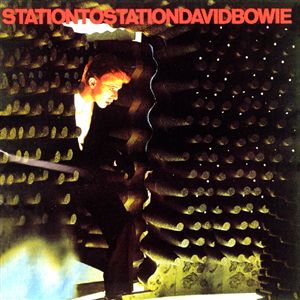The Man Who Fell To Earth

By 1975, David Bowie had become a qualified commercial and critical success in both America and Britain. However, he was beginning to crack under the strain of the fame he had once craved. Bowie was an articulate and sensitive artist slowly morphing into a paranoid, manic depressive. Aided, in no small part, by a diet heavy on cocaine and amphetamines. In a lot of ways, Bowie was the Thom Yorke of the 70s: cynical and paranoid about the world around him, obsessed with privacy, and constantly experimenting with his music.
In early 1976, Bowie began recording Station To Station in Hollywood. He was at the height of his coke addiction/paranoia; and, to this day, he still claims that he has barely any memory of the recording sessions for Station To Station. Regardless, it still stands as one of his greatest musical achievements. Bowie's previous album Young Americans was a pastiche of American soul/R&B music, and also netted Bowie his first #1 single, "Fame", as well as another huge hit with the title track. In less than a year, Bowie was dismissing Young Americans as "the squashed remains of ethnic music. . .written and sung by a white limey." While Station To Station retained some of Young Americans' soul and funk rhythms, it also seamlessly incorporated the rhythms and textures of German progressive music like Kraftwerk and Neu (he would use these influences to greater effect on the subsequent album Low). At its core, Station To Station is a cerebral funk/avant-rock album. I always like to note that this album definitely laid the groundwork for a lot of the music that the Talking Heads would create during their career.
This new amalgam of funk/soul music, German motorik rhythms, and Bowie's patented dramatic art-rock boils to a froth on the epic title track. In fact, the title track is the most blatant example of Bowie's new musical interests. It shifts gears several times and builds to a breathtaking climax. "Golden Years" is a relatively straightforward and incredibly infectious funk-rock song like "Fame" and became an equally popular single. "Word On A Wing" is one of Bowie's best, if not greatest, ballads. In my book, it's on par with "Heroes." It contains one of Bowie's most heartfelt and passionate vocal performances and a serpentine melody t
 hat writhes and glides under the vocals. It's the kind of song that the Arcade Fire built their reputation on. "TVC 15" starts off innocently enough with a jaunty piano part reminiscent of Hunky Dory's aesthetic, but, the choruses quickly give way to an unstoppable ascending guitar riff accentuated an equally glorious piano line. "Stay" is another funk-rock song in the vein of "Golden Years" but with a more complex structure and some incendiary guitar solos courtesy of Carlos Alomar. I have to add that Carlos Alomar is a very worthy successor to Mick Ronson. Alomar's style was unique and innovative, and, always served Bowie's songs appropriately. Carlos was Bowie's lead guitarist from '75 to '79 -covering Station To Station, Low, 'Heroes', and Lodger. "Wild Is the Wind" is the final song of Station To Station and another beautiful ballad. It closes the album on a hymn-like note with another perfect vocal performance. Cat Power did a wonderful rendition of this song on her Covers Record.
hat writhes and glides under the vocals. It's the kind of song that the Arcade Fire built their reputation on. "TVC 15" starts off innocently enough with a jaunty piano part reminiscent of Hunky Dory's aesthetic, but, the choruses quickly give way to an unstoppable ascending guitar riff accentuated an equally glorious piano line. "Stay" is another funk-rock song in the vein of "Golden Years" but with a more complex structure and some incendiary guitar solos courtesy of Carlos Alomar. I have to add that Carlos Alomar is a very worthy successor to Mick Ronson. Alomar's style was unique and innovative, and, always served Bowie's songs appropriately. Carlos was Bowie's lead guitarist from '75 to '79 -covering Station To Station, Low, 'Heroes', and Lodger. "Wild Is the Wind" is the final song of Station To Station and another beautiful ballad. It closes the album on a hymn-like note with another perfect vocal performance. Cat Power did a wonderful rendition of this song on her Covers Record.Station To Station was a brilliant transitional album bridging the gap between Bowie's funk/soul fixations and his experimental Brian Eno-produced Berlin trilogy. However, unlike most transitional albums, Station To Station contains a sound and style all its own.
* Trivial Fun Fact: Bowie's girlfriend at the time was Slash's mom, Ola Hudson, and he would sometimes sing baby Slash to sleep at night.

0 Comments:
Post a Comment
<< Home